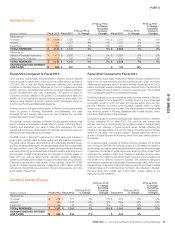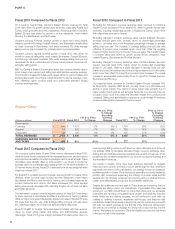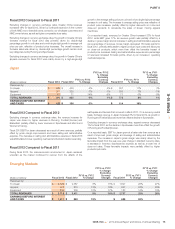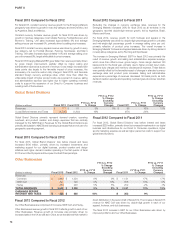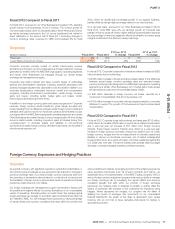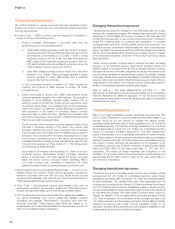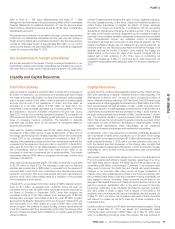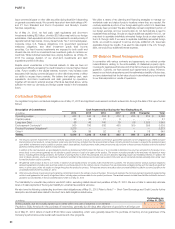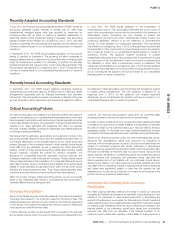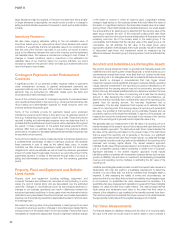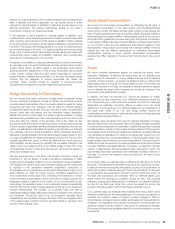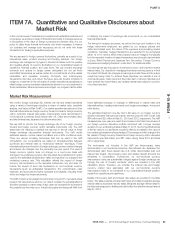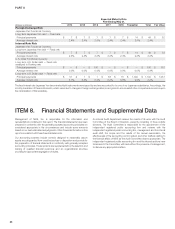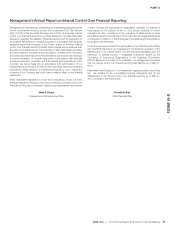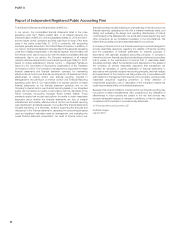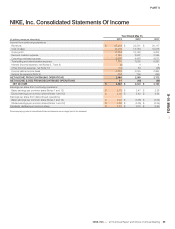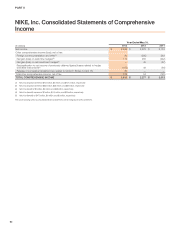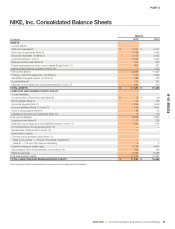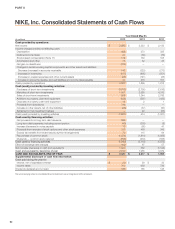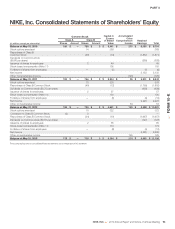Nike 2013 Annual Report Download - page 38
Download and view the complete annual report
Please find page 38 of the 2013 Nike annual report below. You can navigate through the pages in the report by either clicking on the pages listed below, or by using the keyword search tool below to find specific information within the annual report.
PART II
liability in an orderly transaction with a market participant at the measurement
date. In general, and where applicable, we use quoted prices in active
markets for identical assets or liabilities to determine the fair values of our
financial instruments. This pricing methodology applies to our Level 1
investments, including U.S. Treasury securities.
In the absence of active markets for identical assets or liabilities, such
measurements involve developing assumptions based on market observable
data, including quoted prices for similar assets or liabilities in active markets
and quoted prices for identical or similar assets or liabilities in markets that are
not active. This pricing methodology applies to our Level 2 investments such
as commercial paper and bonds, U.S. agency securities and money market
funds. Level 3 investments are valued using internally developed models with
unobservable inputs. Assets and liabilities measured using unobservable
inputs are an immaterial portion of our portfolio.
A majority of our available-for-sale securities are priced by pricing vendors and
are generally Level 1 or Level 2 investments, as these vendors either provide a
quoted market price in an active market or use observable inputs without
applying significant adjustments in their pricing. Observable inputs include
broker quotes, interest rates and yield curves observable at commonly
quoted intervals, volatilities and credit risks. Our fair value processes include
controls that are designed to ensure appropriate fair values are
recorded. These controls include an analysis of period-over-period
fluctuations and comparison to another independent pricing vendor.
Hedge Accounting for Derivatives
We use forward and option contracts to hedge certain anticipated foreign
currency exchange transactions as well as certain non-functional currency
monetary assets and liabilities. When the specific criteria to qualify for hedge
accounting has been met, changes in the fair value of contracts hedging
probable forecasted future cash flows are recorded in other comprehensive
income, rather than net income, until the underlying hedged transaction
affects net income. In most cases, this results in gains and losses on hedge
derivatives being released from other comprehensive income into net income
some time after the maturity of the derivative. One of the criteria for this
accounting treatment is that the forward and option contracts amount should
not be in excess of specifically identified anticipated transactions. By their very
nature, our estimates of anticipated transactions may fluctuate over time and
may ultimately vary from actual transactions. When anticipated transaction
estimates or actual transaction amounts decline below hedged levels, or if it is
no longer probable that a forecasted transaction will occur by the end of the
originally specified time period or within an additional two-month period of
time thereafter, we are required to reclassify the cumulative changes in fair
values of the over-hedged portion of the related hedge contract from other
comprehensive income to other (income) expense, net during the quarter in
which such changes occur.
We have used and may, in the future, use forward contracts to hedge our
investment in the net assets of certain international subsidiaries to offset
foreign currency translation related to our net investment in those subsidiaries.
The change in fair value of the forward contracts hedging our net investments
is reported in the cumulative translation adjustment component of
accumulated other comprehensive income within shareholders’ equity, to the
extent effective, to offset the foreign currency translation adjustments on
those investments. As the value of our underlying net investments in wholly-
owned international subsidiaries is known at the time a hedge is placed, the
designated hedge is matched to the portion of our net investment at risk.
Accordingly, the variability involved in net investment hedges is substantially
less than that of other types of hedge transactions and we do not expect any
material ineffectiveness. We consider, on a quarterly basis, the need to
redesignate existing hedge relationships based on changes in the underlying
net investment. Should the level of our net investment decrease below
hedged levels, the cumulative change in fair value of the over-hedged portion
of the related hedge contract would be reported directly to earnings in the
period in which changes occur.
Stock-based Compensation
We account for stock-based compensation by estimating the fair value of
stock-based compensation on the date of grant using the Black-Scholes
option pricing model. The Black-Scholes option pricing model requires the
input of highly subjective assumptions including volatility. Expected volatility is
estimated based on implied volatility in market traded options on our common
stock with a term greater than one year, along with other factors. Our decision
to use implied volatility was based on the availability of actively traded options
on our common stock and our assessment that implied volatility is more
representative of future stock price trends than historical volatility. If factors
change and we use different assumptions for estimating stock-based
compensation expense in future periods, stock-based compensation
expense may differ materially in the future from that recorded in the current
period.
Taxes
We record valuation allowances against our deferred tax assets, when
necessary. Realization of deferred tax assets (such as net operating loss
carry-forwards) is dependent on future taxable earnings and is therefore
uncertain. At least quarterly, we assess the likelihood that our deferred tax
asset balance will be recovered from future taxable income. To the extent we
believe that recovery is not likely, we establish a valuation allowance against
our net deferred tax asset, which increases our income tax expense in the
period when such determination is made.
In addition, we have not recorded U.S. income tax expense for foreign
earnings that we have determined to be indefinitely reinvested outside the
U.S., thus reducing our overall income tax expense. The amount of earnings
designated as indefinitely reinvested offshore is based upon the actual
deployment of such earnings in our offshore assets and our expectations of
the future cash needs of our U.S. and foreign entities. Income tax
considerations are also a factor in determining the amount of foreign earnings
to be indefinitely reinvested offshore.
We carefully review all factors that drive the ultimate disposition of foreign
earnings determined to be reinvested offshore and apply stringent standards
to overcome the presumption of repatriation. Despite this approach, because
the determination involves our future plans and expectations of future events,
the possibility exists that amounts declared as indefinitely reinvested offshore
may ultimately be repatriated. For instance, the actual cash needs of our U.S.
entities may exceed our current expectations, or the actual cash needs of our
foreign entities may be less than our current expectations. This would result in
additional income tax expense in the year we determined that amounts were
no longer indefinitely reinvested offshore. Conversely, our approach may also
result in a determination that accumulated foreign earnings (for which U.S.
income taxes have been provided) will be indefinitely reinvested offshore. In
this case, our income tax expense would be reduced in the year of such
determination.
On an interim basis, we estimate what our effective tax rate will be for the full
fiscal year. This estimated annual effective tax rate is then applied to the year-
to-date pre-tax income excluding infrequently occurring or unusual items, to
determine the year-to-date tax expense. The income tax effects of infrequent
or unusual items are recognized in the interim period in which they occur. As
the fiscal year progresses, we continually refine our estimate based upon
actual events and earnings by jurisdiction during the year. This continual
estimation process periodically results in a change to our expected effective
tax rate for the fiscal year. When this occurs, we adjust the income tax
provision during the quarter in which the change in estimate occurs.
On a quarterly basis, we reevaluate the probability that a tax position will be
effectively sustained and the appropriateness of the amount recognized for
uncertain tax positions based on factors including changes in facts or
circumstances, changes in tax law, settled audit issues and new audit activity.
Changes in our assessment may result in the recognition of a tax benefit or an
additional charge to the tax provision in the period our assessment changes.
We recognize interest and penalties related to income tax matters in income
tax expense.
NIKE, INC. 2013 Annual Report and Notice of Annual Meeting 83
FORM 10-K


